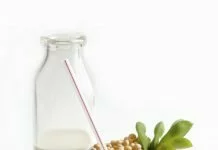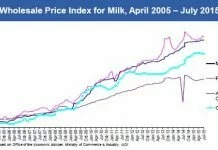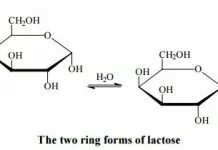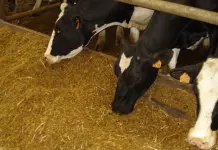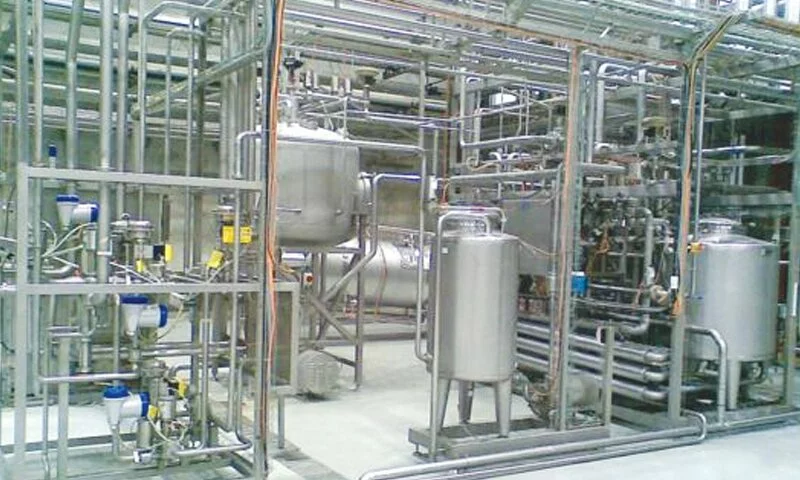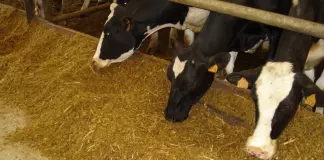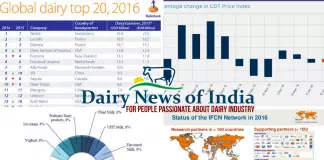Opportunities And Challenges in The Indian Dairy Industry
By- Dr K.G. Karmakar 1 and Dr G.D. Banerjee
Dairy industry is of crucial importance to India. The country is the world’s largest milk producer, accounting for more than 13% of world’s total milk production. It is the world’s largest consumer of dairy products, consuming almost 100% of its own milk production. Dairy products are a major source of cheap and nutritious food to millions of people in India and the only acceptable source of animal protein for large vegetarian segment of Indian population, particularly among the landless, small and marginal farmers and women. Dairying has been considered as one of the activities aimed at alleviating the poverty and unemployment especially in the rural areas in the rain-fed and drought-prone regions. In India, about three-fourth of the population live in rural areas and about 38% of them are poor. In 1986-87, about 73% of rural households own livestock. Small and marginal farmers account for three-quarters of these households owning livestock, raising 56% of the bovine and 66% of the sheep population.
According to the National Sample Survey of 1993-94, livestock sector produces regular employment to about 9.8 million persons in principal status and 8.6 million in subsidiary status, which constitute about 5% of the total work force. The progress in this sector will result in a more balanced development of the rural economy.
Policy
The total amount of milk produced has more than tripled from 23 million tonnes back in 1973 to 74.70 million tonnes 26 years later in 1998. The tremendous rise in milk production is primarily the fallout of the dairy farming policy reflected in Operation Flood. Following the success of dairy farming policy, the Government has set up a dairy processing policy, reflected in the Milk and Milk Products Order. In addition, the Government uses a a variety of import restrictions to protect its domestic dairy market.
Milk Processing
The milk processing industry is small compared to the huge amount of milk produced every year. Only 10% of all the milk is delivered to some 400 dairy plants. A specific Indian phenomenon is the unorganised sector of milkmen, vendors who collect the milk from local producers and sell the milk in both, urban and non-urban areas, which handles around 65-70% of the national milk production. In the organised dairy industry, the cooperative milk processors have a 60% market share. The cooperative dairies process 90% of the collected milk as liquid milk whereas the private dairies process and sell only 20% of the milk collected as liquid milk and 80% for other dairy products with a focus on value-added products.
Domestic Consumption
The huge volume of milk produced in India is consumed almost entirely by the Indian population itself, in a 50-50 division between urban and nonurban areas. Increasingly, important consumers of the dairy industry are fast-food chains and food and non-food industries using dairy ingredients in a wide range of products. Trade In spite of having largest milk production, India is a very minor player in the world market. India was primarily an import dependent country till early seventies. Most of the demand-supply gaps of liquid milk requirements for urban consumers were met by importing anhydrous milk fat / butter and dry milk powders.
But with the onset of Operation Flood Programme, the scenario dramatically changed and commercial imports of dairy products came to a halt except occasional imports of very small quantities. In the 1990s, India started exporting surplus dairy commodities, such as SMP, WMP, butter and ghee. The Agricultural and Processed Food Products Export Development Authority (APEDA) regulated the export and import of dairy products till early 1990s. However, in the new EXIM Policy announced in April 2000, the Union Government has allowed free import and export of most dairy products.
The major destinations for Indian dairy products are Bangladesh (23.1%), UAE (15.4%), US (15.6%) and Philippines (8.9%). In terms of products, SMP is the most important product accounting for about 63% of total export volume, followed by ghee and butter (11.7%) and WMP. Export figures clearly demonstrate that the Indian dairy export is still in its infancy and the surpluses are occasional. Indigenous milk products and desserts are becoming popular with the ethnic population spread all over the world. Therefore, the export demand for these products will increase and hence, there is a great potential for export.
On the other hand, there has been a sharp increase in import of dairy products (especially milk powders) after trade liberalisation. As per the latest report of Foreign Trade Statistics of December 2004, the imports of dairy products (milk and cream) has reached a cumulative total of 22.145 million tonnes for the period April – March 2004, as compared to only 1473 million tonnes for the same period during the previous year. The main reasons for sharp rise in imports are huge export subsidies given by developed countries (mainly the US and EU). India has recently concluded a tariff rate quota to deal with US, EU and Australia on imposing custom duty of 15% on imports of SMP and WMP upto 10,000 tonnes and 60% on imports beyond this level.
Key Areas of Concern in the Dairy Industry
(i) Competitiveness, cost of production, productivity of animals etc.
The demand for quality dairy products is rising and production is also increasing in many developing countries. The countries which are expected to benefit most from any increase in world demand for dairy products are those which have low cost of production. Therefore, in order to increase the competitiveness of Indian dairy industry, efforts should be made to reduce cost of production. Increasing productivity of animals, better health care and breeding facilities and management of dairy animals can reduce the cost of milk production. The Government and dairy industry can play a vital role in this direction.
(ii) Production, processing and marketing infrastructure
If India has to emerge as an exporting country, it is imperative that we should develop proper production, processing and marketing infrastructure, which is capable of meeting international quality requirements. A comprehensive strategy for producing quality and safe dairy products should be formulated with suitable legal backup.
(iii) Focus on buffalo milk based specialty
Dairy industry in India is also unique with regard to availability of large proportion of buffalo milk. Thus, India can focus on buffalo milk based specialty products, like Mozzarella cheese, tailored to meet the needs of the target consumers.
(iv) Import of value-added products and export of lower value products
With the trade liberalisation, despite the attempts of Indian companies to develop their product range, it could well be that in the future, more value-added products will be imported and lower value products will be exported. The industry has to prepare themselves to meet the challenges.
(v) Provisions of SPS and TBT
At the international level, we have to ensure that provisions of SPS and TBT are based on application of sound scientific principles and should become defacto barriers to trade.
Dairy sector witnessed a spectacular growth between 1971-1996, i.e. Operation Flood era. An integrated cooperative dairy development programme on the proven model of Anand pattern was implemented in three phases. The National Dairy Development Board was designated by the Government of India as the implementing agency. The major objective was to provide an assured market round the year to the rural milk producers and to establish linkage between rural milk production and urban market through modern technology and professional management.
Milk production grew from 21 million tonnes in 1970 to nearly 69 million tonnes in 1996 – more than three fold, at the compound growth rate of 4.5 per cent. Some ten million farmers were enrolled as members in about 73000 milk cooperative societies. By 1996, milk cooperatives attained a dominating share of the Indian dairy market – butter 96%, pasteurized liquid milk over 90%, milk powder 59% and processed cheese 85%. India was reckoned as a major threat in the dairying world. In retrospect, it was by no means an easy task.
Let us all salute the visionary and the architect of the white revolution in India, Dr. Verghese Kurien, without whose dynamic leadership all this may not have been possible. The dairy cooperative movement has continued to grow in the post Operation Flood-era.
New Challenges of Globalisation and Trade Liberalisation – Perspective 2010
The NDDB has recently put in place Perspective 2010 to enable the cooperatives to meet the new challenges of globalization and trade liberalization. Like other major dairying countries of the world, the Indian cooperatives are expected to play a predominant role in the dairy industry in future as well. However, India is in the mean time, attaining its past glory and is once again becoming DOODH KA SAGAR. But, what percentage of this SAGAR is handled by the cooperatives – just a little over 7%. Since liberalization of the dairy sector in 1991, a very large number of private sector companies / firms have, despite MMPO, established dairy factories in the country. The share of the total milk processing capacity by private sector is 44% of total installed capacity of 73 MLPD (Million Litres Per Day) in the country. Therefore, the total share of the organized sector, both cooperatives as well as the private sector is barely 12%. What is, therefore, disquieting is that as much as 88% share of the total milk production is commanded by the unorganized sector – who specializes in selling sub-standard, unpasteurised milk more often than not adulterated with harmful chemicals.
Besides, growth in milk production is likely to continue at the present rate of 4.4% in the near future. Who is going to handle this incremental milk? We must bear in mind is both income and price what we must bear in mind both income & price elasticity account for approximatily 15% of the total expenditure of food. Demand for milk, at current rate of income growth is estimated to grow at 7% per annum. Interestingly, demand for milk is expected to grow steadily over the next two decades as the low income rural and urban families who have higher expenditure elasticity would also increase their income due to new economic environment. Let us now look at some other economic indicators.
According to the World Bank, India is the fourth largest economy in the world going by the purchasing power parity estimates. Further, India has been identified as among the first 10 emerging markets in the world. India has the vastest domestic market in the world with over one billion consumers – a majority of whom are vegetarians with drinking of milk as habit.
The untapped potential of the dairy sector is immense and opportunity to set up a new dairy venture is great. In the works of Dr. Amrita Patel, Chairperson, NDDB, there is enough place under the scheme for both private and cooperative sectors. Notwithstanding the above potential it is cautioned that, entering dairy sector is not going to be a cakewalk.
Conclusion Globalization and Liberalization are the Mantras of the new economy today, which is now on the fast track. Industrial production is rapidly moving forward. The dairy industry is no exception. With the World Trade Organization (WTO) coming into effect, from 01 April 2001 and the imports and exports getting liberalized in the global economy, the dairy industry, which includes dairy products, faces both an opportunity for growth as well as a threat for its growth.
There is no doubt that there is tremendous scope for the growth of the dairy industry in the new millennium. The product mix of world dairy trade is likely to shift further towards cheese. This has been developed in the world markets.
As the market opens up, consumption trends associated with these markets will have increasing influence on the world trade. Whole milk powder is likely to continue to be a substantial beneficiary and growth substiantially in the middle eastern countries. As standards of living in the importing country rises, exporting countries will increasingly concentrate on whole milk powder and cheese with the assistance of butter and skimmed milk powder. There is vast potential for the export of dairy products, the cost of milk production in India being the lowest. The major factor influencing production of bye products is the newer uses that may be developed through R & D support.
Milk proteins are being utilized increasingly replacing animal and vegetable proteins in special bakery products and instant foods. Through the application of membrane proven process, milk proteins isolates are being produced. These are being utilized for ice milk mixes and other such applications. Most of the dairy plants in the Government, Cooperatives and Private Sector produce almost similar dairy products like varieties of milk, butter, ghee, skimmed milk powder and whole milk powder.
There are 7 large-scale cheese manufacturers and 14 manufacturers are producing infant foods and malted milks. There is immense scope for the broadening of the products range and some of the products, which are likely to have considerable demand in the coming decade, have been identified. The cheese market, presently valued at about Rs.80 crore is growing at about 9% annually. There are more than thousand varieties of cheese, which have been listed out of which cheddar; mozzarella, gouda and processed cheeses are being manufactured in India.
Pizza is becoming a very popular item in the market. This segment alone commands 5% of the share in the cheese market and other area is fermented milk products. Dahi even though is a Rs.15000 crore market, the share of the organized sector is only around 10%. This product has immense potential for growth.
Varieties of milk shakes are also increasing wherein milk and fruit pulp are mixed in different proportions to produce different beverages. Some of the milk and fruit based beverages which are likely to have demand are a combination of milk with mango, banana, sapota, strawberry, papaya, etc. Some of these beverages can also be produced in dehydrated form and can be an excellent health food.
There are varieties in traditional milk based sweets, manufactured in the country. The market size is around Rs.12000 crore. However, there are very few nationally known brands in this category. Many of the organized dairies are involved in the manufacture of varieties of milk based sweets: pedha, paneer, shirkhand, etc.
These are now restricted to certain areas only but can go national. As the world is getting integrated into one market, quality certification is becoming essential in the market. However, there are very few plants in the country, which have successfully obtained ISO, HACCP certification. There is scope for introducing newer plants adopting newer processes by the dairy industry in the country.
Packaging of dairy products is also another very promising area. NRI and overseas investments can take place in manufacturing dairy processing equipment, fruit packaging equipment and equipments for biotechnology related dairy industry.










